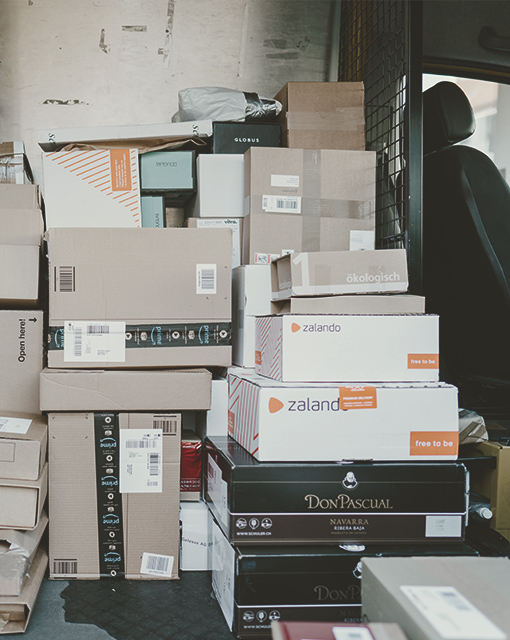Freight and Curb Space During COVID-19
Partner with Us to Pivot Our Research
Essential businesses around the country burst with activity, doing their part to keep supply chains big and small moving. While the COVID-19 crisis has affected lives first and foremost, it has also affected all of the measurables we monitor in the freight and transportation fields: the activity of ports, markets, and distribution centers; the amount of people and goods traveling on our roads; even the types of vehicles being used for deliveries and how the use of the curb has evolved to support distribution. While the public and private sectors have performed good work in responding to the nation’s needs, we are all in a wait-and-see mode in regards to both how long this will last and to what extent production, distribution, and consumer behavior (and everything that flows from them) will be forever altered.
With this background in mind, we have been starting conversations and listening to some of the key questions being asked by our clients and partners across the country during the COVID-19 response. We are now taking action to accelerate new practices and innovations that were already in our 2020 Research & Development (R&D) agenda. Additionally, we are moving to identify the best ways to help agencies plan for and respond to this uncertain future, but also with an eye toward advancing our industry’s best practices into the future.
What We’re Hearing
- The Working From Home Status – How long will this experiment, in which a third of the nation is working from home, last? What durable effects will it have on consumer behavior – everything from grocery shopping and food preparation to how and when we shop?
- More Deliveries – The US Postal Service, Amazon, UPS, and other delivery and logistics companies are doing their best to keep the nation supplied. How has this supercharged the ‘direct to consumer’ retail model, how has it worked, and what might this mean long term?
- More Curb Space – Is more required to support the increase in deliveries and retail ‘dark store/pick-up’ models? What are the impacts to other curb users, and who should have priority access to the curb?
- Tool Availability– What tools are available, and how can they be implemented quickly and at low cost to manage increases in curb space pick-up/delivery?
- Operational and Policy Changes – What are the operational changes needed by retail to optimize the use of pick-up/delivery for curb spaces? What policies are needed to support these changes?
- Technology Advancements – Automation and robots are sometimes viewed as threats by labor unions because they lead to job losses. Will this crisis accelerate development of ‘no-touch’ delivery systems and robots that can work in close quarters? How might these shifts impact productivity, and how might delivery robots/drones be deployed?
- Shifting Manufacturing Hubs and Supply Chains – Will this crisis lead to changes in where goods are manufactured and how they are distributed? Will it result in additional urban distribution hubs to speed last mile delivery (and bring new traffic/routing challenges)?

How We’re Responding
- Expanding Online Retail Travel Impacts – For deeper understanding, we are diving into literature review and data analysis on how expanded online retail and delivery are impacting consumer travel patterns and last mile freight delivery.
- Enhancing our CurbSpace+ Tool – We are making adjustments to CurbSpace+ so that it better forecasts how demand for the curb (from buses, pick-up/drop-off, deliveries, retail transactions, TNCs/taxis, and parking) translates into linear feet and the effect on roadway traffic of different curb-supply scenarios.
- Measurement and Tracking of Key Travel Pattern Shifts – Working with our partners in the public and private sector, including transit agencies, public works departments, departments of transportation, and big data vendors, we will be actively monitoring the major travel pattern trends we have seen change in response to COVID-19, including telecommuting, reduced business travel, less transit travel, increased online shopping, and increased walking/biking (in some areas).
- Urban Freight Data Analysis Phase 2 – We will expand on our Phase 1 analysis of urban freight demand, using data from Seattle to collect new data and further identify urban freight delivery generation; now in a post-COVID-19 condition.
- Autonomous Freight Research – Expanding on our NCHRP Freight Preparedness Study, we will develop guidance on the potential infrastructure needs of autonomous freight vehicles, the potential timing for when improvements may be needed, and strategies on sharing infrastructure costs between the public and private sector.
- Freight VMT Analysis – Freight represents the fastest growing sector of transportation greenhouse gas (GHG) emissions; a trend likely to accelerate in a post-COVID-19 environment. To support state and local vehicle miles traveled (VMT) and GHG emissions reductions goals and regulations, we will expand on our freight VMT research and tools developed for clients such as ODOT and Caltrans to be updated to current conditions and with modern freight vehicle technologies. Mitigation measures to reduce VMT and GHG emissions will also be identified.
- Freight OD Big Data – We will test new big data sources to evaluate freight vehicle origin-destination flows. Additionally, we plan to partner with East and West Coast ports and Big Data vendors to evaluate flows and compare those to traditionally collected data in order to refine suggested practices for using Big Data.
What We’re Seeking
How is the pandemic changing things and how can we further shift our R&D efforts in response?
Here’s what we’re hearing from clients and partners in the areas of:

